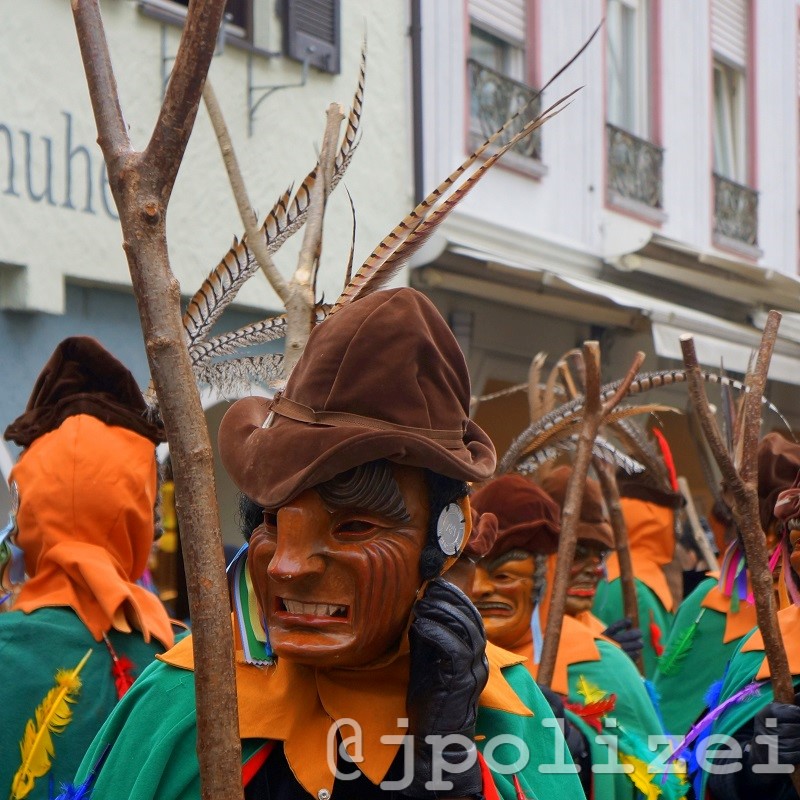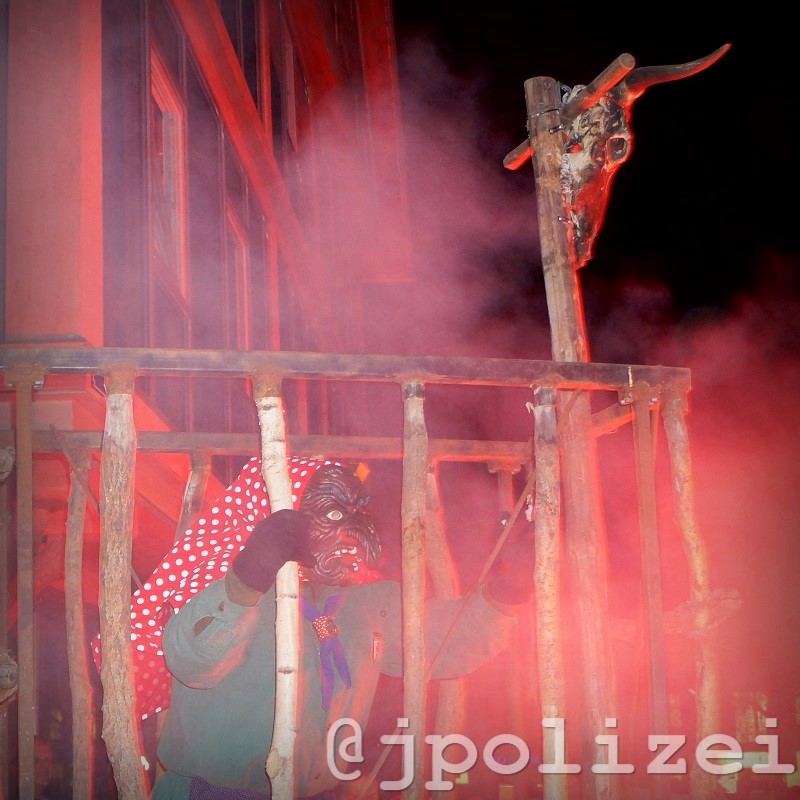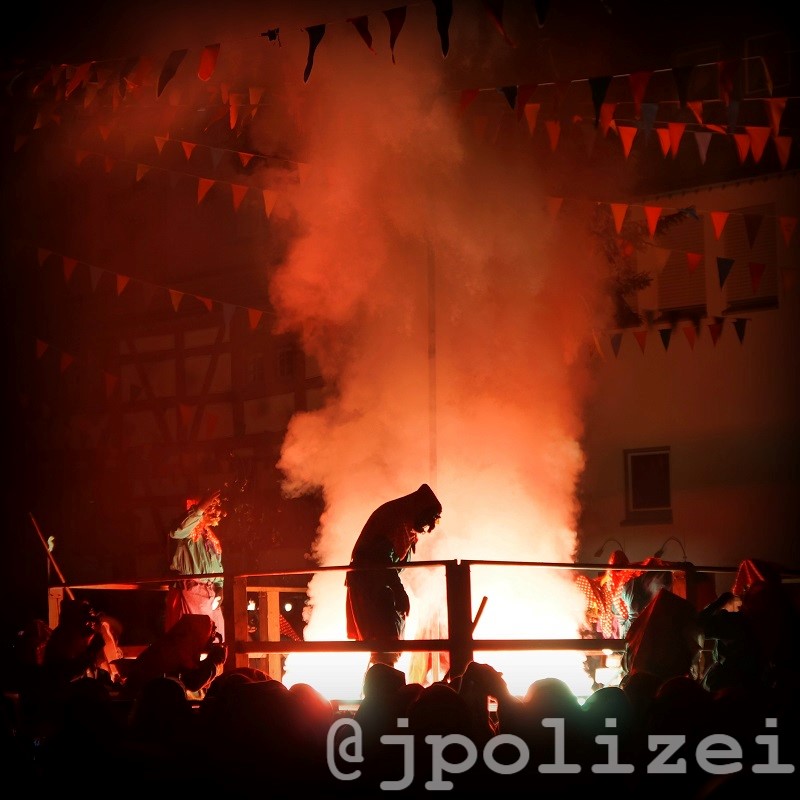The Dark Carnival (Part 2: Fastnacht)
- @jpolizei

- Mar 6, 2019
- 11 min read

"There are windows to the soul which only open now and then. There is a familiar tenderness in your cherished notions of yourself and your desire to become one with a place. Or your desire to be someone else. Those innermost secrets on the road to self-discovery: Who you can also be...
And so, among other things, comes Fastnacht."
- José F. A. Oliver (Mein andalusisches Schwarzwalddorf)
Fastnacht. Fasnacht. Fasnet. Fasent. The name varies from village to village, along with the costumes and wooden masks, the customs, the events. It is, in any case, a surprisingly common feature of most communities in the Swabian-Alemannic regions of Central #Europe: a mountainous swath of forests, pastureland, peaks, and steep river valleys stretching roughly from Alsace across the French border through #Germany’s Black Forest to the Swabian Alps, along the shores of Lake Constance in the border regions of Northern Switzerland and Austrian Vorarlberg.
There are, of course, many similarities with Carnival/Karneval, even with New Orleans’ #MardiGras. All events unfold according to the Catholic holidays: They appear in some variation across most of the #Catholic world. There are street parades. Sometimes with a little bit more flare. More fanfare, more 'tradition.' More cachaça, more Bier. Mal so, mal so.

There is often an element of political satire. Poking fun at local celebrities. In the Swabian and Alemannic worlds, so the story goes, the traditions run deeper still. Historians trace at least some aspects of the traditions back to the Middle Ages—the burning of witches at the market squares, the cries of costumed revelers transformed into starving peasants dying of bubonic plague.
Some memories have an afterlife. The plethora of different soldier costumes recall the countless violent occupations that have shaped this volatile and long unconquerable region at the heart of Europe—an area through which the Romans once built the Limes Germanicus, the Great Wall of China's inglorious cousin: a barbarian retaining wall stretching from the waters of the #Danube to the #Rhine.

Rome, Prussia, France, Sweden, Bavaria, Hapsburg Austria-Hungary all had their moments of dominion. Baden. Hohenzollern. Württemberg. Swabia. Most of the region is encompassed by the modern German state of Baden-Württemberg. But the memories of so much violent upheaval and so many locally-rooted enmities run deep. Cross lines. The modern event may be mostly fun and games, but the masks and costumes, at the very least, take recourse to these cultural memories: long-festering wounds. The posttraumatic stress of generations.

Other costumes seem to hint at something older and deeper still. #Krampus-style winter demons. Wild men and witchy women. Bell-clad flower people. Bonfires. The primordial victory of springtime over winter cold. So the story goes.
Fool’s masks are actually the oldest surviving wooden masks. These predate all later costumes and date back at least to the Early Modern—perhaps a celebration or a recognition of the truth behind the period's obsession with jesters and fools. An embodiment of the sentiment behind Swiss author Sebastian Brant’s immensely popular 1494, Das Narrenschiff [Ship of Fools].

The morals of his collected stories seem to suggest that regardless of the refinements life brings, we all remain, in the end, nothing but laughable fools. The enduring image of a ship of fools afloat on turbid waters served at least as partial inspiration for Michel Foucault’s now-classic 1961 Madness and Civilization [Folie et Déraison: Histoire de la folie à l'âge classique]. Alongside witches and demons, fools masks are a common feature of Fastnacht, too. Perhaps, at its core, the masked revelry is nothing more than a way of accepting the simple truth of our inner fools.

Despite local assertions in the areas where Fastnacht is celebrated, no written records of Fastnacht date back to before Christianization in the early Middle Ages. A few scattered admonitions from the extended German-speaking world were penned by disapproving monks in Latin and Mittelhochdeutsch in the 13th and 14th centuries. They note the tendency of Rhinelanders in general to succumb to yearly bouts of drunken buffoonery, pulling decorated carts from village to village in the weeks before the fast of Lent. Similar traditions existed in France and Northern Italy. Perhaps they had also existed in pre-Christian Germania (Tacitus asserted something of the like). Saturnalia were documented in pre-Christian Rome.

Ancient pagan fertility festival or not, modern Swabian-Alemannic #Fastnacht is far from an “invented tradition,” even if its longevity requires a bit more bureaucracy these days. Fastnacht remains much more than the prolific local fools’ guilds or Narrenzünfte which organize the events today. It is a time during which communal bonds are renewed, friendships are renegotiated, and social boundaries are retested. And the traditions evoked by many of the masks come straight from local legends and #folklore. For all the modern fanfare, some traditions do run deep.

Recourse to ritualized anarchy and drunken chaos offered peasants in the Early Modern a chance to seize control over the uncertainties of their daily lives—even if only for a few days’ time. It offered them a brief period of controlled chaos in the face of uncontrollable fate. The fast of Lent to mark the end of winter made sense in a pragmatic way back then, as well. By the end of February, your last supplies from autumn were becoming scarce. Last year's harvest might not make it through to springtime after all. Why not go out with a bang?
Codified, officialized, regulated or not, there remains something subversive about #carnival. Something dark about the carnivalesque. Despite Fastnacht participants' nods to 'ancient German tradition' (sufficient to pique the interest of Nazi researchers obsessed with identifying the Germanic roots of modern European society), the inhibitions of the upside-down world saw many such events banned during the Third Reich. The potential to subvert the status quo was just too great. Since the 1950s, there has been an explosion of new Narrenzünfte. Across the Swabian-Alemannic world nearly every town and village, no matter how small, retains a fools’ guild of its own, complete with unique masks or costumes and at least a few local experts willing to impart their knowledge of village tradition over a homemade schnapps or pint of beer. There is a very communal vibe to the pre-Fastnacht preparations. Many of the fools' guilds, and indeed many independent groups of local residents, prepare for months in advance.

Membership and participation in the fools guilds varies greatly from village to village. Many are closely guarded and deeply tied to participation in (and potentially exclusion from) local communities—German historians like Utz Jeggle have argued that these social collectives today serve as a final bulwark for maintaining shared village identity in the face of ongoing demographic shifts. Still, the #carnivalesque, the upside-down world, with its emphasis on the inversion of order, its prioritization of the bodily, the carnal, invites both excess and change. And the anonymity of the masked revelry destabilizes daily routine, despite the fools' guilds' potential for also reinforcing communal ties.

The two are not mutually exclusive. Staged as well as impromptu concerts, plays, and comedy sketches abound during the fifth season. The building of floats and the participatory performances during the parades take prep and practice. There is absolutely a community-building function to participating in Fastnacht, and the communities in which I experienced it were more than happy to take in a curious outsider.
But my experiences with Brazilian carnival taught me that revelry is never without its consequences. As an academic, or perhaps simply as a conscientious outsider, there are aspects of some Fastnacht celebrations which make me uncomfortable. The very emphasis on excess, the prolific consumption of alcohol, and the potential for masked hooliganism under cover of darkness tests the limits and the inhibitions of all participants. Although the generally playful back and forth between Fastnacht revelers typically unfolds without major consequence, ceremonial ‘kidnap’ and ‘torture’ of young parade-goers (mostly young women) could certainly exceed the expressed desires and cross lines for some of even the most public ‘victims.’

Rarely does a year go by without reports of violence, rape, or sexual transgression during carnival week somewhere in Germany. Fastnacht celebrations are certainly not exempt from this ugly truth. The secretive nature of some Narrenzünfte, and the sworn comradery of masked bands encourages certain participants to push the limits of fool’s liberty to extremes. In 2018, a group of masked witches from Kraichgau dropped a young woman into a pot of boiling water during a Fastnacht parade. Although one participant was eventually identified and charged for the crime, the collective guild continues to maintain their ignorance of the event.
Of course this kind of blatant transgression is definitely the exception to the rule. As explained to me, most 'victims' know in advance that they will be 'captured' during parades. Most participants are on board.
Still I found the staging of witch burnings a bit hard to handle at first glance. Ask a local participant about the meaning behind such a staged event, and the default answer is that it’s not about the witch at all. It’s a burning effigy of winter—out with the old, in with the new. A celebration of the spring. Yet the casual evocation of gendered violence and the often-graphic reenactments—in which caged and customed witches are paraded before audiences then discreetly swapped out for life-sized effigies and set alight—are carried out on the self-same village squares where centuries before real women were burned at the stake. That gives me more than a little cause to stop and consider the modern implications of these celebrations. How would an American audience feel about the celebratory re-staging of a lynching mob?

But here again the lines are less clear cut than one might hope. Analogies and analyses are not so easily drawn. Witches are not still burned at the stake in modern Germany. By its very nature, the upside-down world of carnival also encourages the blurring of traditional societal expectations and gender roles. Recent field work by German sociologist Kerstin Bronner has begun to investigate the performative, emancipatory potential of such events, as well. Cross-dressing, for example, is commonplace. Many of the witches are played by men, just as many of the soldier and peasant masks are worn by female participants. In some ceremonies, witches burn other witches. In some, they burn last year’s Christmas trees. While the burning of a witch effigy is disturbing, despite (or indeed, perhaps due to) the many layers of tradition behind the act, what exactly does it mean for women soldiers in drag to burn a man clad in a dress and wearing the grotesque mask of an old woman? Is the crossing of borders, the blurring of normative social values explicit or implicit for Fastnacht participants? Is this actually a way to work through trauma or rethink uncomfortable norms?

There is a level of brutality to the ritualized #violence in certain Fastnacht celebrations, but also the telltale potential for something more. As I watched the cheering crowds celebrate the symbolic burning of a #witch this year, I was oddly reminded of the communal violence of a mosh pit. When I'd told a buddy in Berlin the week before that I was traveling to go see Fastnacht he'd scoffed. Carnival, he'd said, was really not his idea of fun. He’d rather go to punk shows during Carnival week.

Maybe he wasn't familiar with the distinctions between Fastnacht and Karneval. But I was a bit baffled by his comparison at first. After a week of Fastnacht, the #moshpit analogy now seems strangely prescient. Jesse Michaels once wrote, describing the intensity of the live show:
“Music is an indirect force for change, because it provides an anchor against human tragedy. In this sense, it works towards a reconciled world. It can also be the direct experience of change. At certain points during some shows, the reconciled world is already here, at least in that second, at that place […] Those seconds reveal that the momentum that drives a subculture is more important than any particular band. The momentum is made of all the people who stay interested, and keep their sense of urgency and hope.”
I can’t remember the first time I slammed in a mosh pit as a preteen. But as far back as I can remember, I was always fascinated by the organized #chaos, the untargeted release. As an angsty teenager I was intrigued by the recognition that the same fist that might lay you out on the floor often becomes the hand which scoops you back up off the ground; the same violently gesticulating bodies slamming against one another in the circle pit will also block the march of stomping feet when someone in the group falls down. The hours of adrenaline before, during, and after a high-energy show are unlike most other experiences. The sweat, the pain, the complete release and surrender to mob mentality. Ripped t-shirts and bloodied lips. I can’t remember the first time I slammed in the pit, but I certainly remember the last dozen times in bruising detail.
With time, I guess I become more observant (and more prone to feeling hangovers and pain). Or I become more self-critical of the things I enjoy. Sure there's been revival, but aging #punk bands are overwhelmingly white and male. Yet the audiences at many punk shows today are anything but. The anonymity of the darkened dance floor can be a far less hostile place than it appears. I continue to be fascinated by the way committing to the mosh pit quickly rattles preconceived notions about gender, age, race, and class.

There are few experiences in civilian life that facilitate the kind of instant comradery: the collective experience of anarchy without explicit target or purpose. The anonymous draw of Fastnacht might not be so different. The 'violent' aspects of its celebrations are largely symbolic after all. Reenactments. Recontextualizations. Out with the old, in with the new. In the hours following the Hexenverbrennung [witch burning] I saw this year in Germany, I talked to a number of friends back home in the States. Trying to describe my fascination with the mob mentality, I found myself again and again drawn to the analogy of moshing.

There's something not quite right about a tradition of burning an individual human form that we are supposed to see as alive and sentient, one friend observed. But it’s still better than actual violence, I guess.

Is it helpful to reactivate bad memories and seek to give them new meaning?Most everyone I interacted with was having a great time (myself included, but for the heebeegeebees I felt during the burn). Not a single participant I talked to saw my connection with medieval witch burnings as relevant to their celebratory "death of winter." Most were genuinely startled at the comparison. Still, there was something primeval about the collective energy of the crowd during this event. The anticipation, the release. Is this the catharsis of the Greek theater re-tuned for the 20th and 21st centuries? And if so, could participation in such an event actually encourage or hinder delinquency in real life?
Decades of participation during live shows would seem to suggest to me that the collective release of aggression certainly can promote community formation in a given context. I've seen lots of blood and bruising, but I rarely see actual fights at shows.
As an interested outsider with some very attentive local guides, my experiences of Fastnacht were truly something memorable. People went out of their way to make things as accessible for me as possible, and I came away, as with every visit to rural Germany, with a slew of new friends. I was also pleasantly surprised at one of the Fastnacht celebrations I visited to see that I was not the only person receiving an active lesson in local #tradition. An older woman stood across from me during one parade with a group of young Syrian refugees. After all, Fastnacht can be a pretty scary place for kids, especially if you have no idea about the context. The woman was explaining the different costumes to them, the dos-and-don'ts for receiving candy or avoiding being scared—rehearsing snippets of the chants in local #dialect. Their pure and unabashed delight was one of my biggest takeaways from the week. Theirs was probably the candy. Their negotiation of the local customs earned them a lot of bon-bons—pillowcases full, in fact. But hopefully it also gave them something more: a newfound insight into the communities to which they now belong.
Despite its checkered history and the increasing threat of renewed political violence, Germany today is one of the safest and most orderly countries in the world. Does their broad social acceptance, indeed, their celebratory codification of chaos during the ‘fifth season’ encourage or discourage social cohesion in their day-to-day? For better and for worse, Fastnacht remains a time when—for one tumultuous week—#community ties are inverted, negotiated, redefined. Is there really more to it than revelry? S goht dr gega, s goht scho wieder dr gega! The jury is still out.

(See Part 1: How it all Connects for the Backstory!)





















Comments